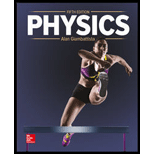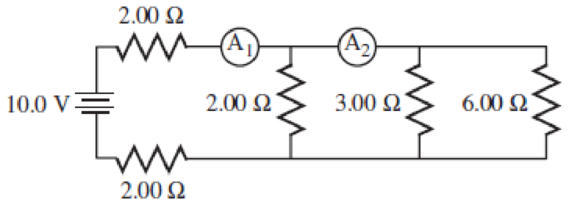
Physics
5th Edition
ISBN: 9781260486919
Author: GIAMBATTISTA
Publisher: MCG
expand_more
expand_more
format_list_bulleted
Textbook Question
Chapter 18, Problem 111P
A1 and A2 represent ammeters with negligible resistance. What are the values of the currents (a) in A1 and (b) in A2?

Expert Solution & Answer
Want to see the full answer?
Check out a sample textbook solution
Students have asked these similar questions
A student finds two ancient meters with numbered scales but no unit markings. He thinks that one is an ammeter and one is a voltmeter but doesn't know which is which. He measures the resistance of each, finding that meter A has a resistance of 5000 ohms and meter B has a resistance of 0.01 ohms. He can conclude that
Group of answer choices
A is the voltmeter and B is the ammeter.
neither can be a useful meter.
B is the voltmeter but A cannot be a useful meter.
A is the voltmeter but B cannot be a useful meter.
B is the voltmeter and A is the ammeter.
What is the current (in A) passing through resistor 3 in the circuit if V = 12 V, R1 = 18 Q, R2 = 6 Q, and R3 = 3 0?
Give your answer as only the numerical value in the SI units specified. e is interpreted as x10^ for use with large or small values; 1.01e2 is interpreted as 1.01 x 102.
R1
R2
R3
R1= 3.00 ohms, R2 = 6.00 ohms and R3 = 5.00 ohms. The battery has negligible internal resistance. The current I2 through R2 is 4.00 A. What are the currents I1 and I3?
Chapter 18 Solutions
Physics
Ch. 18.1 - CHECKPOINT 18.1
In a water pipe, there is an...Ch. 18.1 - Prob. 18.1PPCh. 18.3 - Prob. 18.3CPCh. 18.3 - Prob. 18.2PPCh. 18.4 - Prob. 18.4CPCh. 18.4 - Prob. 18.3PPCh. 18.4 - Prob. 18.4PPCh. 18.4 - Prob. 18.5PPCh. 18.6 - Prob. 18.6CPCh. 18.6 - Prob. 18.6PP
Ch. 18.6 - Prob. 18.7PPCh. 18.7 - Prob. 18.8PPCh. 18.8 - Prob. 18.9PPCh. 18.9 - Prob. 18.10PPCh. 18 - Prob. 1CQCh. 18 - Prob. 2CQCh. 18 - Prob. 3CQCh. 18 - Prob. 4CQCh. 18 - Prob. 5CQCh. 18 - 6. A friend says that electric current “follows...Ch. 18 - Prob. 7CQCh. 18 - Prob. 8CQCh. 18 - Prob. 9CQCh. 18 - Prob. 10CQCh. 18 - Prob. 11CQCh. 18 - Prob. 12CQCh. 18 - Prob. 13CQCh. 18 - Prob. 14CQCh. 18 - Prob. 15CQCh. 18 - Prob. 16CQCh. 18 - Prob. 17CQCh. 18 - Prob. 18CQCh. 18 - 19. When batteries are connected in parallel, they...Ch. 18 - 20. (a) If the resistance R1 decreases, what...Ch. 18 - Prob. 21CQCh. 18 - Prob. 22CQCh. 18 - Prob. 23CQCh. 18 - Prob. 1MCQCh. 18 - Prob. 2MCQCh. 18 - Prob. 3MCQCh. 18 - Prob. 4MCQCh. 18 - Prob. 5MCQCh. 18 - Prob. 6MCQCh. 18 - Prob. 7MCQCh. 18 - Prob. 8MCQCh. 18 - Prob. 9MCQCh. 18 - Prob. 10MCQCh. 18 - Prob. 1PCh. 18 - 2. The current in a wire is 0.500 A. (a) How much...Ch. 18 - Prob. 3PCh. 18 - Prob. 4PCh. 18 - 5. The current in the electron beam of a computer...Ch. 18 - Prob. 6PCh. 18 - Prob. 7PCh. 18 - Prob. 8PCh. 18 - Prob. 9PCh. 18 - Prob. 10PCh. 18 - Prob. 11PCh. 18 - Prob. 12PCh. 18 - Prob. 13PCh. 18 - Prob. 14PCh. 18 - Prob. 15PCh. 18 - Prob. 16PCh. 18 - Prob. 17PCh. 18 - Prob. 18PCh. 18 - Prob. 19PCh. 18 - 20. A copper wire of cross-sectional area 1.00 mm2...Ch. 18 - 21. An aluminum wire of diameter 2.6 mm carries a...Ch. 18 - Prob. 22PCh. 18 - Prob. 23PCh. 18 - Prob. 24PCh. 18 - Prob. 25PCh. 18 - Prob. 26PCh. 18 - Prob. 27PCh. 18 - Prob. 28PCh. 18 - Prob. 29PCh. 18 - Prob. 30PCh. 18 - Prob. 31PCh. 18 - Prob. 32PCh. 18 - Prob. 33PCh. 18 - Prob. 34PCh. 18 - 35. A battery has a terminal voltage of 12.0 V...Ch. 18 - Prob. 36PCh. 18 - Prob. 37PCh. 18 - Prob. 38PCh. 18 - Prob. 39PCh. 18 - Prob. 40PCh. 18 - Prob. 41PCh. 18 - Prob. 42PCh. 18 - Prob. 43PCh. 18 - Prob. 44PCh. 18 - Prob. 45PCh. 18 - Prob. 46PCh. 18 - Prob. 47PCh. 18 - Prob. 48PCh. 18 - Prob. 49PCh. 18 - Prob. 50PCh. 18 - Prob. 51PCh. 18 - Prob. 52PCh. 18 - Prob. 53PCh. 18 - Prob. 54PCh. 18 - Prob. 55PCh. 18 - Prob. 56PCh. 18 - Prob. 57PCh. 18 - Prob. 58PCh. 18 - Prob. 59PCh. 18 - Prob. 60PCh. 18 - Prob. 61PCh. 18 - Prob. 62PCh. 18 - Prob. 63PCh. 18 - Prob. 64PCh. 18 - Prob. 65PCh. 18 - Prob. 66PCh. 18 - Prob. 67PCh. 18 - Prob. 68PCh. 18 - Prob. 69PCh. 18 - Prob. 70PCh. 18 - Prob. 71PCh. 18 - 72. At what rate is energy dissipated in the 4.00...Ch. 18 - Prob. 73PCh. 18 - Prob. 74PCh. 18 - Prob. 75PCh. 18 - Prob. 76PCh. 18 - Prob. 77PCh. 18 - Prob. 78PCh. 18 - Prob. 79PCh. 18 - Prob. 80PCh. 18 - Prob. 81PCh. 18 - Prob. 83PCh. 18 - Prob. 82PCh. 18 - Prob. 85PCh. 18 - Prob. 84PCh. 18 - Prob. 90PCh. 18 - Prob. 86PCh. 18 - Prob. 87PCh. 18 - Prob. 88PCh. 18 - In the circuit of Problem 88, at what time after...Ch. 18 - Prob. 91PCh. 18 - Prob. 92PCh. 18 - Prob. 94PCh. 18 - Prob. 93PCh. 18 - Prob. 95PCh. 18 - Prob. 96PCh. 18 - Prob. 97PCh. 18 - Prob. 98PCh. 18 - Prob. 99PCh. 18 - Prob. 100PCh. 18 - Prob. 101PCh. 18 - Prob. 102PCh. 18 - Prob. 103PCh. 18 - Prob. 104PCh. 18 - Prob. 106PCh. 18 - Prob. 105PCh. 18 - Prob. 107PCh. 18 - Prob. 108PCh. 18 - Prob. 109PCh. 18 - Prob. 110PCh. 18 - A1 and A2 represent ammeters with negligible...Ch. 18 - Prob. 112PCh. 18 - Prob. 114PCh. 18 - Prob. 113PCh. 18 - Prob. 116PCh. 18 - Prob. 115PCh. 18 - Prob. 118PCh. 18 - Prob. 117PCh. 18 - Prob. 120PCh. 18 - Prob. 119PCh. 18 - Prob. 122PCh. 18 - Prob. 121PCh. 18 - Prob. 124PCh. 18 - Prob. 123PCh. 18 - Prob. 126PCh. 18 - Prob. 125PCh. 18 - Prob. 128PCh. 18 - Prob. 127PCh. 18 - Prob. 130PCh. 18 - Prob. 129PCh. 18 - Prob. 134PCh. 18 - Problems 131 and 132. A potentiometer is a...Ch. 18 - Prob. 132PCh. 18 - Prob. 133PCh. 18 - Prob. 136PCh. 18 - Prob. 135PCh. 18 - Prob. 138PCh. 18 - Prob. 137PCh. 18 - Prob. 139PCh. 18 - Poiseuilles law [Eq. (9-41)] gives the volume flow...
Knowledge Booster
Learn more about
Need a deep-dive on the concept behind this application? Look no further. Learn more about this topic, physics and related others by exploring similar questions and additional content below.Similar questions
- A 10.00-meter long wire cable that is made of copper has a resistance of 0.051 ohms, (a) What is the weight if the wire was made of copper? (b) What is the weight of a 10.00-meter-long wire of the same gauge made of aluminum? (c)What is the resistance of the aluminum wire? The density of copper is 8960 kg/m3 and the density of aluminum is 2760 kg/m3.arrow_forwardWhat is the total current (in A) passing through the circuit if V = 12 V, R1 = 40 Q, R2 = 20 Q, and R3 = 40 0? Give your answer as only the numerical value in the SI units specified. e is interpreted as x10^ for use with large or small values; 1.01e2 is interpreted as 1.01 x 104. R2 R1 R3arrow_forwardNerve cells transmit electrical signals through their long tubular axons. These signals propagate due to a sudden rush of Na + ions, each with charge +e, into the axon. Measurements have revealed that typically about 5.8 x 1011 Na + ions enter each meter of the axon during a time of 15 milliseconds. What is the current during this inflow of charge in the axon?arrow_forward
- Two conductors are made of the same material and have the same length. Conductor A is a solid wire of diameter 1.1 mm. Conductor B is a hollow tube of outside diameter 2.5 mm and inside diameter 1.4 mm. What is the resistance ratio RA/RB., measured between their ends? Number Unitsarrow_forwardIn the adjacent circuit, the voltages and voalues of resistance are unknown. The value of the current running through R1 is 5.3 mA going from left to right, and the current through R3 is 1.8 mA from the top of R3 to the bottom. The value of the current through R2 running from right to left (in mA) is: R1 R2 R3 V1 V2 O a. 2.65 O b. 10.60 O c.7.10 O d.-3.50 O e. 3.50arrow_forwardV 1 , V 2 , V 3 , and I1 , I2 , I3 apply to the respective resisters. V C and Q refer to the capacitor's voltage and charge. U C refers to the capacitor's stored energy (electric potential energy). If VC = 6 volts, calculate Q in μ C.arrow_forward
- Wires 1 and 2 are made of the same material. Wire 2 has 1/3 the length and 1/3 the diameter of wire 1. What are the ratios R₂/R₁ of the resistances of the wires? A) R₂/R₁ = 9 B R₂/R₁ = 3 C) R₂/R₁ = 1/3 D R₂/R₁ = 1/9 E None of the other answers is correctarrow_forwardIn the following Figure, R1=0.5 Ohm, R2=0.5 Ohm, and R3=5 Ohm. The current through R2 is 4.00 A. What is the total voltage of the battery (EMF) ? Assume the battery has no internal resistance. R1 R2 R3arrow_forwardQ1. a) Using mesh analysis, find 1₁ and 12 in the circuit of Figure1. j10Ω 40/30° V (+ -j20 2= 40 92 1₂ 50/0°V Figure1 b) Verify the answers of 1₁ and 1₂ obtained in part a by using multisim simulation. (Screenshot of the circuit in multisim simulation with the values of 1₁ and 12 are required).arrow_forward
- Two resistors, R1 = 21 Ω and R2 = 35 Ω are connected in parallel across a battery providing voltage ΔVbat = 5.7 V. What is the current through resistor R1?arrow_forwardTwo resistors R1=6 and R2=12 are connected in parallel to each other and in series to R3=2. An ammeter measures an electric current of 3A flowing through resistor R3. What is the net voltage applied to the current?arrow_forwardA battery with terminal voltage ΔV = 2.6 V contains E = 2.6 kJ of energy. It is connected to a P = 9.5 W light bulb. Find an expression for the light bulb's resistance, R. What is the resistance in ohms? Assuming the voltage remains constant, how long will the battery last in seconds?arrow_forward
arrow_back_ios
SEE MORE QUESTIONS
arrow_forward_ios
Recommended textbooks for you

How To Solve Any Resistors In Series and Parallel Combination Circuit Problems in Physics; Author: The Organic Chemistry Tutor;https://www.youtube.com/watch?v=eFlJy0cPbsY;License: Standard YouTube License, CC-BY